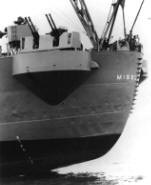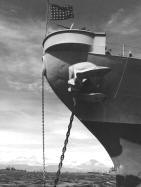|
The SS
United States was the brainchild of one of the world's foremost marine architects, William
Francis Gibbs. His dream was to build a passenger ship that was faster, safer and more
technologically advanced than anything else afloat. It was truly a construction project
that challenged conventional thinking. In 1952, his dream became a reality when the SS
United States crossed the North Atlantic in 3 days, 10 hours and 42 minutes averaging
35.59 knots (65.48 km/hr or 40.96 mph). The design characteristics encompassing the United
States read straight out of a James Bond novel, many remaining classified by the Navy well
into the late 70's:
- Her
241,000 horsepower engines allowed her to reach a top speed of 43 knots (79.12 km/hr or
49.48 mph)* at 990'6" in length, she is the largest passenger vessel ever built in
the United States.
- Materials in
construction included over 2,000 tons of aluminum; she has a power-to-weight ratio that
has never been equaled
- She
could steam 10,000 miles without stopping for fuel or supplies.
- The ship
was totally fireproof, being constructed completely of non-flammable materials (publicists
were so fond of pointing out that the only wood on board were in her pianos and the
chopping blocks).
The SS
United States' $79 million construction cost was heavily underwritten by the federal
government. After the wartime success of Britain's Queen Mary and Queen Elizabeth, as
troop transports, the Navy wanted a superliner of their own that could be easily converted
to troopship duty. Such was the case when the British government called on the liner Queen
Elizabeth 2 to transport British troops to the Falkland Islands in 1982. The United States
was constructed so that in just one day, she could be converted into a troop transport
capable of carrying over 15,000 men. She could outrun anything afloat and steam non-stop
anywhere in the world in less than 10 days. Although she was briefly on stand-by during
the Cuban Missile Crisis in 1962, she was never called to troop-ship duty.
Throughout her brief 17-year career, the United States held a near perfect schedule and
never experienced an engineering failure. By comparison, the Queen Elizabeth 2 experienced
recurring engine troubles that dated as far back as her builder's sea trials in 1969. It
was so plagued with turbine troubles that after being adrift at sea without power on more
than two occasions, her troublesome steam turbines were finally replaced with diesel units
in 1986.
Toward the end of the sixties, the jumbo jet invasion finally took its toll on the famous
trans-Atlantic superliners. On frequent sailings, the ship's 1000-plus crew often
outnumbered paying passengers. In November 1969, faced with on-going union troubles and
declining profits, the United States was sent to the Newport News Shipbuilding and Drydock
Company in Newport News, Virginia for her annual overhaul. As fate would have it, her
boilers were never fired again. As the years passed, she remained docked in Norfolk,
Virginia with little hope of revival.
The Pentagon, which was largely responsible for her construction, was, ironically, largely
responsible for her demise. Because of the ship's highly secret design specifications, one
of the stipulations that was incurred by the government was that the ship could never be
sold to foreign interests. In the late 1970's Norwegian Caribbean Cruise Lines was looking
for a large vessel that it could convert to cruise service. After being turned down by the
Maritime Administration to purchase the SS United States, the company purchased the idled
superliner France from the French government, rechristened her Norway, and returned her to
service as the world's longest cruise ship.
In 1973 the Maritime Administration installed an extensive dehumidification system
throughout the United States, leaving it virtually airtight. The system proved remarkably
well when an unfaded copy of the New York Times from November 1969 was found in a lounge,
ten years later. It was evident at this point that the government had no future plans for
the United States. Once the proud flagship of a nation, the Maritime Administration now
saw the SS United States as a liability on their balance sheet. In 1978, the Maritime
Administration accepted a bid of $5 million from Seattle-based United States Cruises Inc.
who planned to return the ship to service as the world's first condominium-style cruise
ship. The ship's new owner, Richard H. Hadley, planned to finance the $150 million refit
by selling cabins on a time-share basis. Brochures were printed, press releases issued and
even contracts with shipyards signed, but nothing ever came to pass. Unable to pay the
mounting dockage fees, in February 1992, United States Cruises Inc. was forced into
bankruptcy. U.S Mar-shoals seized the ship and filed a court motion to sell the ship at
auction.
The ship's fate was sealed. After a failed attempt at returning her to service, the ss
United States, it seemed, would wind up at the ship breakers somewhere in the far east. A
stay of execution was granted when Fred Mayer of Marmara Marine Inc., purchased the ship
at auction for $2.6 million. Mayer, chairman of Commodore Cruise Lines, emigrated to the
United States in the mid-60's aboard the ss United States. He and his partners, one of
which was a wealthy shipyard owner in Istanbul, Turkey, negotiated a plan with Cunard who
would operate her as a running mate to the Queen Elizabeth 2. The ship would sail between
New York and Southampton in the summer months while the winter months would be spent
cruising the tropics. In June 1992, the ship departed U.S. waters in tow, for Istanbul,
Turkey, where once financing was secured workers would restore the ship to her former
glory.
Originally designed as a fireproof ship, asbestos was used extensively in the ship's
interior construction. An asbestos compound called Marinite was used in favor of plywood.
The ship was loaded with it and if she were to sail in the 90's, the compound would have
to be removed. Workmen began the arduous process of stripping the ship's interior right
down to her metal bulkheads. As was the case ten years earlier, attempts to secure
government assistance in the project proved unsuccessful. Furthermore, faced with
corporate restructuring, Cunard was no longer interested in operating another ship,
especially one the size of the United States. It was thought that she would never see U.S.
waters again, but in July 1996 the SS United States returned to her homeland, but this
time to Philadelphia, where the dormant Navy yard would reopen with the task of restoring
the superliner to it's long lost former glory. As before, financing for the enormous
project failed to materialize. The ship remains idle, awaiting the final chapter of her
story.
* It is now known that the SS United States achieved speeds exceeding 44
knots, or 50mph (footnote by the SS United States Foundation).
|


